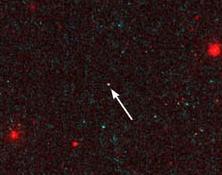Young neutron stars may rotate as fast as 1000 times per second, but magnetic braking slows them down to periods less than 0.01 times per second over a timescale of millions of years. This rotational dynamo creates an electric field that accelerates electrons away from the poles, beaming out relativistic jets of radiation. If the beamed jet is along the line of sight to earth, we see pulses, and call these objects pulsars. Pulses may be produced over a wide range of energies, from gamma-rays to radio.
Because neutron stars are so small, they have a low luminosity and even the closest isolated neutron stars appear to be very faint. Geminga @ 160pc is 26th magnitude. Optical spectra of neutron stars should show a black-body curve with a peak around 3Å, but effects from synchrotron radiation and/or ion cyclotron resonance contribute significantly. The few optical spectra of isolated neutron stars (pulsars) include HST observations of PSR0656+14, and a Keck spectrum of Geminga, where there is a flat power-law shape to the continuum and a broad dip over 6300-6500Å (Martin et al, 1998).
Relativistic effects are pronounced in the vicinity of these ultra-dense objects. The gravitational bending of light-paths allows photons from any given part of the star to be bent around and escape from the opposite side of the star. This has implications when studying high-energy bursts.
Many neutron stars have companions, and these interesting binary systems can be studied in the optical and high-energy realms. See the section on exotic binaries for some examples.
The Crab nebula contains a neutron star pulsar with polar jets, equatorial winds, an accretion torus, and a period of ~30 rps. These features, along with a spectacular nebular remnant from the precurser star and supernova (exploded 1054 A.D.), allow us to study the Crab at all wavelengths.
Recently confirmed are the neutron star sub-class of magnetars.
These are young, rotating neutron
stars with INTENSE magnetic fields (100 trillion - 1 quadrillion gauss).
Magnetars are believed to be the source of the soft gamma-ray repeaters,
as magnetic stresses may crack the crust, triggering starquakes and
causing the crust to vibrate. These vibrations would in turn energize
charged particles near the surface to emit high-energy radiation.
Large starquakes would produce huge-bursts of gamma rays.
Magnetar candidates include SGR1900+14, SGR1806-20, and SGR0526-66.
 Isolated neutron star
RXJ185635-3754
Isolated neutron star
RXJ185635-3754This is the first direct look, in visible light, at a lone neutron star, as seen by HST (September, 1997). The Hubble results show the star is very hot (1.2 million degrees Fahrenheit at the surface), tiny (no larger than 16.8 miles (28 kilometers) across), and faint (below 25th magnitude).
Credit: Fred Walter (State University of New York at Stony Brook), STScI, and NASA
 Crab Pulsar and local environment.
Crab Pulsar and local environment.Credit: Jeff Hester and Paul Scowen (Arizona State University), STScI and NASA